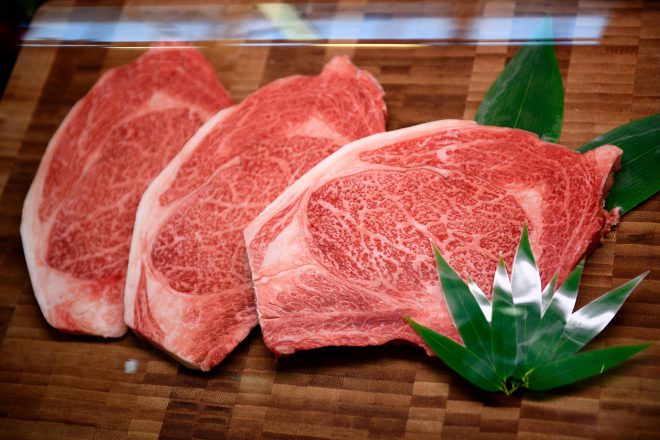Japanese Wagyu Beef Faces Challenge in Australian Market
August 14, 2018
Sydney- Japanese luxury wagyu beef faces a challenge in making inroads into the Australian market, where meat from locally grown crossbred wagyu has already established a presence.
Australia recently resumed imports of Japanese beef after lifting in May a ban introduced in 2001 due to an outbreak of bovine spongiform encephalopathy (BSE), or mad cow disease, in Japan.
Many Australians like lean meat. But highly marbled domestic wagyu beef produced from cattle carrying Japanese genes is also popular.
Kimio Osawa, a wholesaler in Australia, started importing wagyu from Japan in late July. He bought a wagyu cow produced in Kagoshima Prefecture, a prominent wagyu production center in southwestern Japan.
"Japanese wagyu has a look, taste and flavor that can't be realized with Australian breeds," Osawa said.
He said he will advertise the beef via social media.
Japanese wagyu genes were introduced to Australia in the 1990s via the United States.
In Japan, only purebred cattle can be referred to as wagyu, while the Australian definition includes crossbred cattle whose wagyu genetic content is 50 pct or more of the total.
Australian wagyu cattle are fed mainly with wheat and barley and put out to pasture, while Japanese wagyu cattle are mainly fed with corn.
Annual production of Australian wagyu totals some 32,000 tons. The meat is also exported to Asian economies.
In 2001, Japan exported only 403 tons of wagyu to Australia.
Wagyu is expensive even if it is Australian, a consumer said, expressing hope that it will become more affordable through competition with Japanese wagyu.
The Japanese External Trade Organization, or JETRO, plans to hold a business meeting in Sydney on Monday to shore up sales of Japanese wagyu. Jiji Press
Latest Videos
- THE UNTOLD STORY EXPERT INSIGHTS INTO THE UKRAINE
- NEGOTIATING A NEW ORDER US RUSSIA TALKS ON UKRAIN
- Ukraine: A Pawn in the Geopolitical Game? Will Trump Intervene?
- US VP VANCE CRITICIZES EUROPEAN DEMOCRACIES AT MUNICH SECURITY CONFERENCE
- UNCOVERING THE WEB OF DECEIT: CIA INFILTRATION OF THE MEDIA
- SHIFTING SANDS: TULSI GABBARD’S CONFIRMATION AND THE EVOLVING GLOBAL LANDSCAPE
- FAUCI SCANDAL: A THREAT TO GLOBAL HEALTH AND DEMOCRACY






